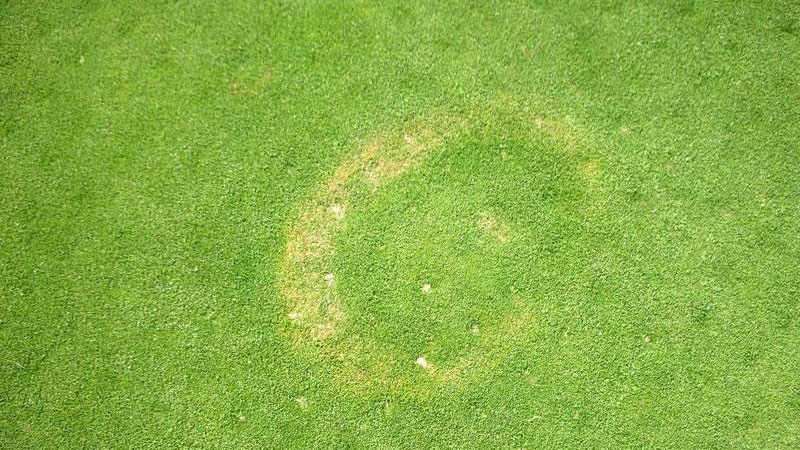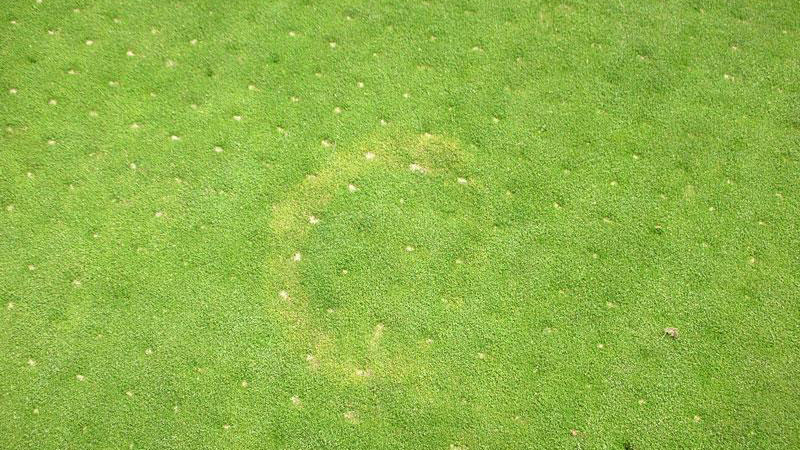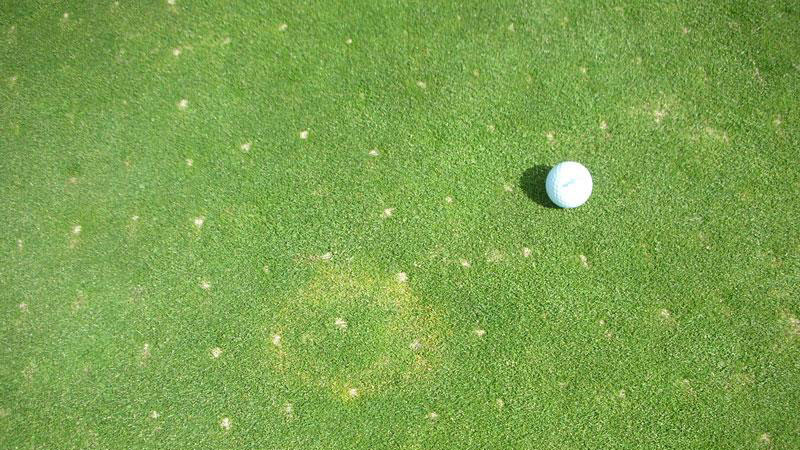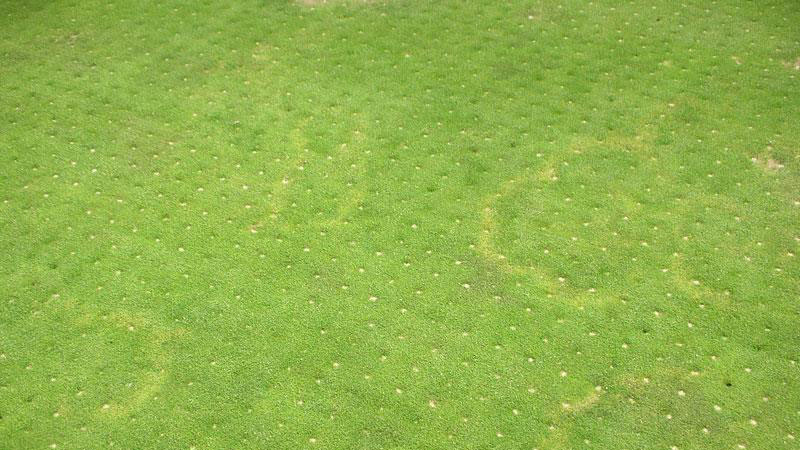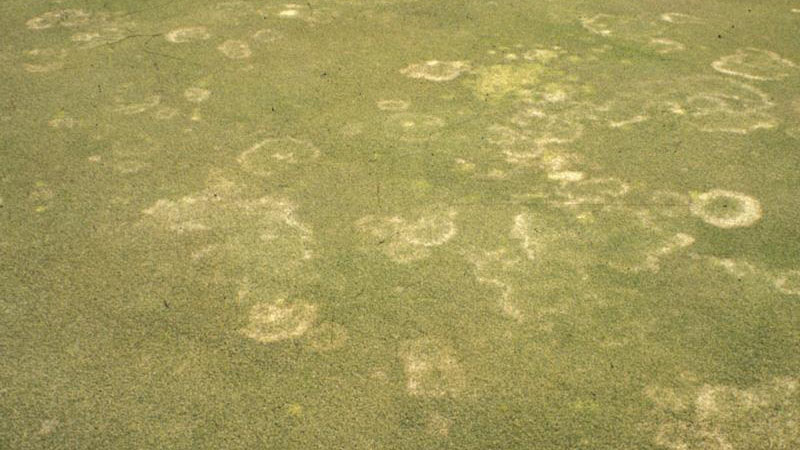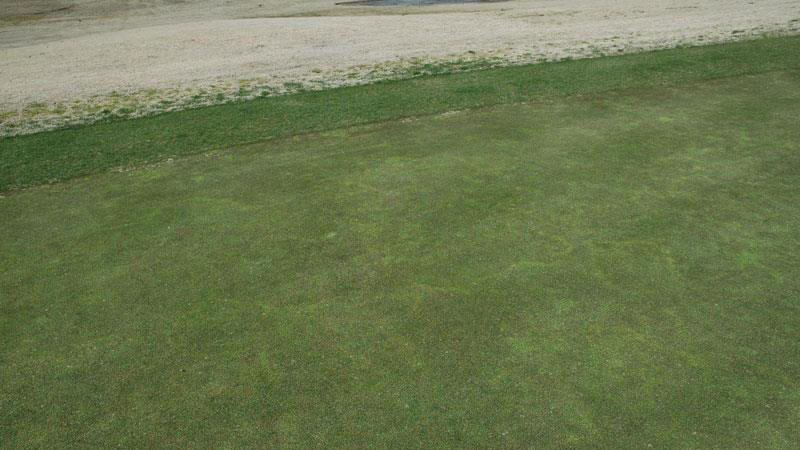Yellow Patch in Turf
en Español / em Português
El inglés es el idioma de control de esta página. En la medida en que haya algún conflicto entre la traducción al inglés y la traducción, el inglés prevalece.
Al hacer clic en el enlace de traducción se activa un servicio de traducción gratuito para convertir la página al español. Al igual que con cualquier traducción por Internet, la conversión no es sensible al contexto y puede que no traduzca el texto en su significado original. NC State Extension no garantiza la exactitud del texto traducido. Por favor, tenga en cuenta que algunas aplicaciones y/o servicios pueden no funcionar como se espera cuando se traducen.
Português
Inglês é o idioma de controle desta página. Na medida que haja algum conflito entre o texto original em Inglês e a tradução, o Inglês prevalece.
Ao clicar no link de tradução, um serviço gratuito de tradução será ativado para converter a página para o Português. Como em qualquer tradução pela internet, a conversão não é sensivel ao contexto e pode não ocorrer a tradução para o significado orginal. O serviço de Extensão da Carolina do Norte (NC State Extension) não garante a exatidão do texto traduzido. Por favor, observe que algumas funções ou serviços podem não funcionar como esperado após a tradução.
English
English is the controlling language of this page. To the extent there is any conflict between the English text and the translation, English controls.
Clicking on the translation link activates a free translation service to convert the page to Spanish. As with any Internet translation, the conversion is not context-sensitive and may not translate the text to its original meaning. NC State Extension does not guarantee the accuracy of the translated text. Please note that some applications and/or services may not function as expected when translated.
Collapse ▲Symptoms
Yellow patch is a common disease of cool-season turfgrasses (bentgrasses, bluegrasses, fescues) during the fall, winter, and spring. Symptoms appear as irregular patches or rings up to 3 feet in diameter that are yellow or white in color. Multiple rings or patches may coalesce to form large, irregularly-shaped areas. Individual plants exhibit a yellow dieback of leaves or blighting of entire plants. No distinct lesions are evident on the affected plants. Recovery from yellow patch can be very slow because it occurs at a time of the year when the turf is growing slowly.
Development Factors
Yellow patch develops during extended periods of cool, cloudy, wet weather. The pathogen is most active when temperatures are between 50 and 65°F, but may cause infections under a broader temperature range (45 to 75°F). Excessive nitrogen applications, heavy thatch accumulations, and poor soil drainage also encourage development of this disease.
Cultural Control
Avoid high rates of nitrogen (> 0.25 lb N/1,000 square feet) during the late fall and early spring when yellow patch is most active, and use slow release fertilizers during this time so as to prevent flushes of foliar growth. Ensure adequate surface and subsurface drainage, and aerify and topdress to reduce thatch accumulations. Pruning or removal of trees will increase sunlight penetration and speed recovery from yellow patch if symptoms appear.
Chemical Control
Yellow patch is best controlled on a preventative basis where it is a persistent problem. Curative applications will prevent further spread, but recovery will be slow if weather conditions are not conducive to turfgrass growth. In North Carolina and other areas of the southern United States, yellow patch can be controlled curatively as fluctuating temperatures in fall, winter, and spring lead to intermittent periods of disease development and turfgrass growth.
* Products marked with an asterisk are not labeled for home lawn use.
| Fungicide and Formulation1 | Amount of Formulation2 | Application Interval (Days)3 | Efficacy Rating | Resistance Risk | FRAC Code4 |
| azoxystrobin (Heritage) WG TL G |
0.4 2 2 to 4 lbs |
28 28 14 to 28 |
++++ | Low | 11 |
| azoxystrobin + acibenzolar-S-methyl (Heritage Action)* | 0.2 to 0.4 | 14 to 28 | ++++ | Low | 11/P01 |
| azoxystrobin + chlorothalonil (Renown)* | 2.5 to 4.5 | 14 to 28 | ++++ | Low | 11/M5 |
| azoxystrobin + difenoconazole (Briskway)* | 0.5 to 1.2 | 14 to 28 | ++++ | Low | 11/3 |
| azoxystrobin + propiconazole (Headway) ME G |
3 2 to 4 lbs |
28 14 to 28 |
++++ | Low | 11/3 |
| azoxystrobin + tebuconazole (Strobe T)* | 1.5 | 14 to 21 | ++++ | Low | 11/3 |
|
benzovindiflupyr + difenoconazole (Ascernity)* |
1.0 | 14 to 21 | ++++ | Low | 7/3 |
| chlorothalonil + fluoxastrobin (Fame C)* | 3 to 5.9 | 14 to 28 | ++++ | Low | M5/11 |
| chlorothalonil + propiconazole + fludioxonil (Instrata)* | 8 to 11 | late fall | +++ | Low | M5/3/12 |
| chlorothalonil + thiophanate-methyl (Spectro)* | 3 to 5.76 | 14 to 21 | ++ | Low | M5/1 |
|
cyazofamid + azoxystrobin (Union) |
5.75 | 28 | ++++ | Low | 21/11 |
| fludioxonil (Medallion) | 0.5 | 1 application | ++ | Low | 12 |
| fluoxastrobin (Fame) SC G |
0.36 2.3 to 4.6 lbs |
28 14 to 28 |
++++ | Low | 11 |
| fluoxastrobin + tebuconazole (Fame T)* | 0.45 to 0.9 | 21 to 28 | ++++ | Low | 11/3 |
| flutolanil (Prostar) (Pedigree) |
1.5 2.2 |
21 to 28 21 to 28 |
+++ +++ |
Low Low |
7 |
| metconazole (Tourney) | 0.37 to 0.44 | late fall | +++ | Low | 3 |
| propiconazole (Banner MAXX) | 3 to 4 | late fall | ++ | Low | 3 |
|
pydiflumetofen + azoxystrobin + propiconazole (Posterity XT)* |
3 | 28 | ++++ | Low | 7/11/3 |
| tebuconazole (Mirage)* | 1 to 2 | 21 to 28 | ++ | Low | 3 |
| triticonazole (Triton FLO) (Trinity) |
0.55 to 1.1 1 to 2 |
21 to 28 21 to 28 |
+++ | Low | 3 |
| triticonazole + chlorothalonil (Reserve)* | 3.2 to 5.4 | 21 to 28 | +++ | Low | 3/M5 |
| 1 Other trade names with the same active ingredients are labeled for use on turfgrasses and can be used according to label directions. 2 Units are oz, fl oz, or lb depending on formulation. Apply fungicides in 2 to 5 gallons of water per 1,000 square feet according to label directions. Use lower rates for preventive and higher rates for curative applications. 3 Use shorter intervals when conditions are very favorable for disease. 4 Fungicide Resistance Action Committe code. Products with same code have the same mode of action and are in the same chemical class. * Products marked with an asterisk are not labeled for home lawn use. |
|||||
| Efficacy Rating ++++ = excellent control when conditions are highly favorable for disease development +++ = good control when disease pressure is high, excellent control when disease pressure is moderate ++ = good control when disease pressure is moderate, excellent control when disease pressure is low + = good control when disease pressure is low ? = not rated due to insufficient data |
|||||
| Resistance Risk Low = Rotate to different chemical class after 3-4 applications; tank mixing not necessary Medium = Rotate to different chemical class after 1-2 applications; tank-mixing with low or medium risk product recommended High = Rotate to different chemical class after EVERY application; tank-mix with low or medium risk product for EVERY application ? = not rated due to insufficient data |
|||||
Species Data
- HOST SPECIES
- creeping bentgrass, annual bluegrass, Kentucky bluegrass, tall fescue
- MONTHS WITH SYMPTOMS
- October to March
- STAND SYMPTOMS
- FOLIAR SYMPTOMS LOCATION / SHAPE
- dieback from leaf tip, blighting of entire leaves, leaf lesions
- FOLIAR SYMPTOMS COLOR
- yellow
- ROOT / CROWN SYMPTOMS
- none
- FUNGAL SIGNS
- none



